Just In
- 2 hrs ago

- 6 hrs ago

- 8 hrs ago

- 9 hrs ago

Don't Miss
- News
 IPL 2024: Ex-cricketer Tells Why Mumbai Indians Replaced Rohit Sharma With Hardik Pandya As Captain
IPL 2024: Ex-cricketer Tells Why Mumbai Indians Replaced Rohit Sharma With Hardik Pandya As Captain - Movies
 Bajrangi Bhaijaan 2: When Pooja Hegde Opened Up About Starring Opposite Salman Khan In The Sequel
Bajrangi Bhaijaan 2: When Pooja Hegde Opened Up About Starring Opposite Salman Khan In The Sequel - Automobiles
 Tata Altroz Records a 55% Sales Growth in March 2024
Tata Altroz Records a 55% Sales Growth in March 2024 - Sports
 IPL 2024: DC vs SRH Live Score & Updates; Rishabh Pant invites Pat Cummins & Co. to bat first; Match starts at 7:30 PM
IPL 2024: DC vs SRH Live Score & Updates; Rishabh Pant invites Pat Cummins & Co. to bat first; Match starts at 7:30 PM - Finance
 Rs 17.50/Share Dividend: Tata Mid Cap To Consider Dividend On April 29, LIC Stake 9.88%
Rs 17.50/Share Dividend: Tata Mid Cap To Consider Dividend On April 29, LIC Stake 9.88% - Education
 Railway RPF Recruitment 2024; Apply Online for 4660 Post Vacancies @rpf.indianrailways.gov.in
Railway RPF Recruitment 2024; Apply Online for 4660 Post Vacancies @rpf.indianrailways.gov.in - Technology
 Best Noise-Cancelling Earbuds Under Rs 5,000: CMF Buds Pro, Redmi Buds 5, Realme Buds Air 5, and More
Best Noise-Cancelling Earbuds Under Rs 5,000: CMF Buds Pro, Redmi Buds 5, Realme Buds Air 5, and More - Travel
 Journey From Delhi To Ooty: Top Transport Options And Attractions
Journey From Delhi To Ooty: Top Transport Options And Attractions
Edible And Nutritious Plants You Can Grow At Home
Growing your own produce is indeed a power move. Nothing can beat the feeling of stepping out to your balcony to pick fresh veggies for your dinner without the worry of it being doused in chemicals and pesticides.
In recent years, with scientific proof and studies leaning towards sourcing your food from local farmers' markets and street vendors, people are opting out of buying vegetables from big supermarkets due to the risk of chemical-exposure and such.
So, wouldn't it be great if you could grow your own nutritious edible plants - right from home? In addition to the benefits of growing your own food, gardening also helps boost your mental health; all in all, it is nothing but a total win-win [1].

Here is a list of all the nutritious plants you can grow at home. The article will include the following:
Tomato
Potato
Peppers
Spring
onion
Microgreens
etc.
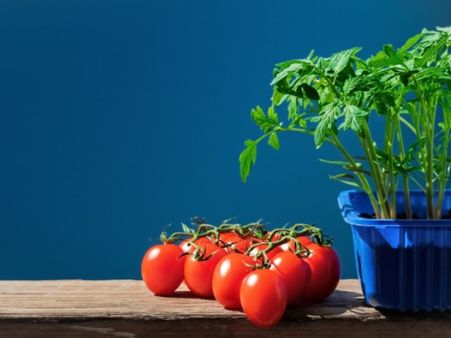
1. Tomato
One of the easiest kitchen plants to grow at home, tomatoes are the primary dietary source of the antioxidant lycopene, which has been linked to many health benefits, including reduced risk of heart disease and cancer [2].
Gardening tip: 6-8 months is the complete life cycle of a tomato plant, so for a continuous supply of tomatoes, start a new plant from seed every two weeks.
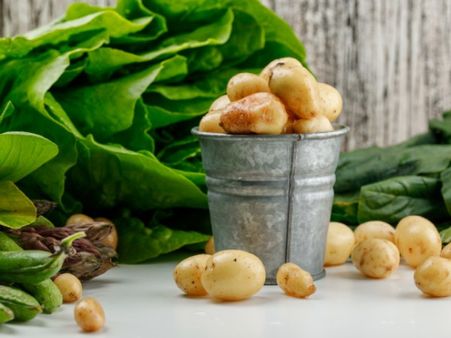
2. Potato
Another easy vegetable to grow at home are potatoes; you may have noticed that sometimes they grow by themselves (sprouts) when you leave potatoes for too long. All you have to do is bury a whole potato in some soil or a glass pot and wait for ten weeks (yes, patience is important). Potatoes are a good source of fibre and can help manage blood sugar levels. They are also full of antioxidants that help prevent diseases and vitamins that help your body function properly [3].
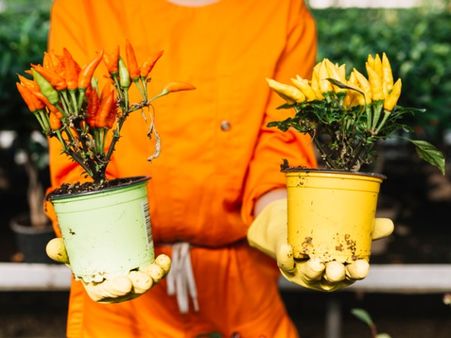
3. Peppers
Peppers are amazing edible plants to grow at home, be it bell peppers, jalapeno or bhut jolokia. All you have to do is collect seeds from a pepper, clean and dry them on a paper towel and plant them in a pot or just spread them out on the garden floor. The many benefits of peppers include low in calories, excellent sources of vitamins A and C, potassium, folic acid, and fibre [4].
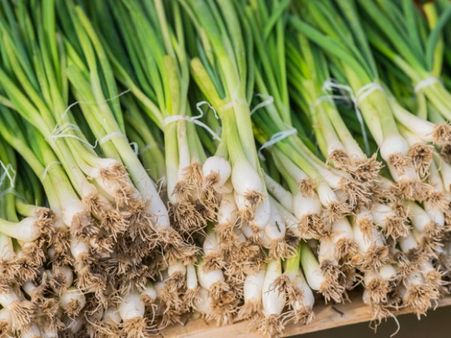
4. Scallion (Spring Onion)
Also known as green onions or spring onions, these are another type of easy to grow nutritious-edible plants. You can start by taking a bunch of spring onions, use a rubber band to tie the bulbs together and place them in a glass filled with one inch of water. In a week, the scallions will lengthen, which then can be transferred to a pot. The benefits of spring onions are that it helps fight inflammation and are loaded with essential nutrients like Vitamins A, C, B2 or thymine, copper, phosphorus, magnesium and potassium [5].
Gardening tip: Change the water daily and keep them in full sun, and water them regularly.
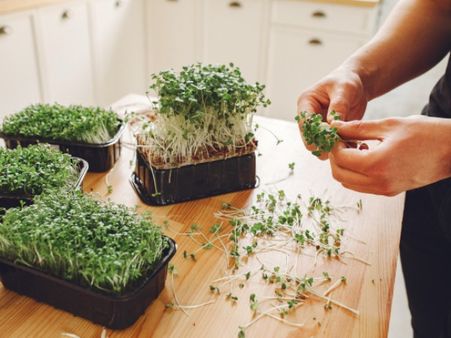
5. Microgreens
Microgreens, also known as micro herbs or vegetable confetti, have gained much popularity in recent times due to their highly concentrated nutritional value. Microgreens are young greens that grow from any vegetable or herb seeds and are one to three inches tall. Different varieties of microgreens provide varying amounts of vitamins, minerals and carotenoids [6]. However, they are rich in nutrients like iron, zinc, potassium, magnesium, manganese, copper, calcium, selenium, molybdenum, vitamin C, vitamin A, vitamin E, vitamin K and a wide variety of polyphenols and other antioxidants [7]. Some of the popular types of microgreens are amaranth, beetroot, spinach, onion, carrot, cabbage etc.
How To Grow Microgreens
- Fill your pot with soil and water it lightly.
- Sprinkle the seeds of your choice on the soil and lightly mist the soil with water.
- Check it daily and ensure that the soil is moist.
- You will see that the seeds have germinated after a few days.
- After 7 to 21 days, the microgreens are ready to harvest.
- Cut the microgreens above the soil and rinse them properly before eating them.
Gardening tip: Place the tray on a sunny windowsill and mist (spray with water) daily. The seeds need 12 to 14 hours of light and germinate in 2 to 3 days.
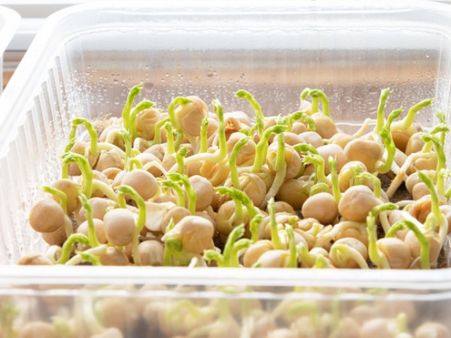
6. Sprouts
Sprouts are one of the healthiest foods with chock-full of vitamins and minerals that benefit your overall health. They are harvested within two to three days [8]. Common sprouts you can grow in your garden include lentil, soybean, mung bean, kidney bean, green pea, garbanzo bean, adzuki bean and black bean, as well as nut and seed sprouts sprouted grained and vegetable and leady sprouts like radish, mustard greens etc.
How To Grow Sprouts At Home
- Rinse the legumes and grains properly and place them in a huge bowl or a mason jar filled with water.
- Cover the bowl or mason jar with a cheesecloth.
- Keep it at room temperature for 3 to 12 hours, or it may take longer than that.
- Once sprouted, drain the water and wash with fresh water once again.
- Consume the sprouts within 3 to 4 days.

7. Lettuce
For growing lettuce, the primary factor is that it should have a cold environment. Lettuce is usually grown in the winter months in the cooler parts of India [9]. They grow within a short span of time and is quite easy to harvest. Lettuce is low in calories, fat and sodium. It is a good source of fibre, iron, folate, and vitamin C [10].
Other healthy plants you can grow at home or in your garden are as follows:
- Coriander
- Mushrooms
- Pumpkin
- Lemon
- Garlic greens
- Basil
Note: Coriander and mushroom require the right kind of environment (and time) to grow. So, they can be a bit difficult to grow in comparison.

On A Final Note…
You
can
buy
the
seeds
for
the
vegetable-fruit
garden
from
a
plant
nursery,
order
online,
or
instead
of
throwing
out
that
capsicum
or
spring
onion,
propagate
it
and
let
your
vegetable
garden
flourish.
-
 improvement8 Edible Plants To Grow Indoor
improvement8 Edible Plants To Grow Indoor -
 healthTaste The Unexpected: 6 Fruits That Look & Taste Like Tomatoes
healthTaste The Unexpected: 6 Fruits That Look & Taste Like Tomatoes -
 insyncAs Tomato Acts Pricey, Hilarious Tomatoey Memes Take Over The Internet
insyncAs Tomato Acts Pricey, Hilarious Tomatoey Memes Take Over The Internet -
 insyncWith Tomato Prices Soaring High, Check Out 8 Substitutes For Fresh Tomatoes And Other Veggies
insyncWith Tomato Prices Soaring High, Check Out 8 Substitutes For Fresh Tomatoes And Other Veggies -
 healthTomato Costs Soar High: 5 Substitutes To Give Tangy Flavour To Your Recipes
healthTomato Costs Soar High: 5 Substitutes To Give Tangy Flavour To Your Recipes -
 beauty3 Ways To Use Tomato For Tightening Facial Pores: For All Skin Types
beauty3 Ways To Use Tomato For Tightening Facial Pores: For All Skin Types -
 beauty3 DIY Tomato Skincare Recipes For Acne Spots
beauty3 DIY Tomato Skincare Recipes For Acne Spots -
 nutritionTomatoes Are Really Good For Your Gut Health: Here’s Why
nutritionTomatoes Are Really Good For Your Gut Health: Here’s Why -
 skin care8 Tomato Masks For Minor Skin Conditions Like Dryness, Dullness, Acne Etc.
skin care8 Tomato Masks For Minor Skin Conditions Like Dryness, Dullness, Acne Etc. -
 skin care6 Simple Ways To Use Tomato For Healthy, Glowing Skin
skin care6 Simple Ways To Use Tomato For Healthy, Glowing Skin -
 wellnessEvidence-Based Health Benefits Of Tomato Juice: Anti-Ageing, Weight Loss, Immunity And More
wellnessEvidence-Based Health Benefits Of Tomato Juice: Anti-Ageing, Weight Loss, Immunity And More -
 wellnessBest Superfoods For Men And Women Over 40
wellnessBest Superfoods For Men And Women Over 40


 Click it and Unblock the Notifications
Click it and Unblock the Notifications



